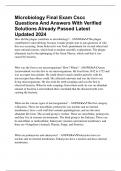-
1. Exam (elaborations) - Cscc questions and answers with verified solutions latest updated 2024
-
2. Exam (elaborations) - Cscc sociology final exam questions and answers with verified solutions 100% correct!...
-
3. Exam (elaborations) - Intro to sociology final exam (cscc) questions and answers with verified solutions al...
-
4. Exam (elaborations) - Cscc accounting 1212 exam 1 study guide questions and answers with verified solutions...
-
5. Exam (elaborations) - Cscc psych final exam questions and answers with verified solutions latest updated 20...
-
6. Exam (elaborations) - Cscc microbiology 2215 final exam review (test 1 material) questions and answers with...
-
7. Exam (elaborations) - Microbiology final exam cscc questions and answers with verified solutions already pa...
-
8. Exam (elaborations) - Cscc chem 1113 exam 5/ hw 12,13,14 questions and answers with verified solutions well...
-
9. Exam (elaborations) - Cscc: physiology exam one questions and answers with verified solutions 100% correct!...
-
10. Exam (elaborations) - Bio 1101 cscc exam 2 questions and answers with verified solutions already passed!!!
-
11. Exam (elaborations) - Cscc thea 1100 exam 1 questions and answers with verified solutions 100% correct!!!
-
12. Exam (elaborations) - Exam 3 review cscc questions and answers with verified solutions already passed lates...
-
13. Exam (elaborations) - Cscc human physiology exam 2 questions and answers with verified solutions already pa...
-
14. Exam (elaborations) - Cscc med/surg: master set for final exam review questions and answers with verified s...
-
15. Exam (elaborations) - Cscc microbiology exam 4 questions and answers with verified solutions already passed...
-
16. Exam (elaborations) - Exam 1/final exam (chp 1-4) - intro to biology (1111) cscc questions and answers with...
-
17. Exam (elaborations) - Cscc pols 1100 final exam study guide questions and answers with verified solutions a...
-
18. Exam (elaborations) - Cscc educational psychology final exam questions and answers with verified solutions ...
-
19. Exam (elaborations) - Pharm 1140 cscc exam 2 questions and answers with verified solutions already passed!!...
-
20. Exam (elaborations) - Cscc- astronomy exam 1 questions and answers with verified solutions latest updated 2...
-
21. Exam (elaborations) - Sociology cscc exam 3 questions and answers with verified solutions 100% correct!!!
-
22. Exam (elaborations) - Corporate finance exam for unit 1-fmgt 2201-cscc questions and answers with verified ...
-
23. Exam (elaborations) - Exam 2 accounting 1211 cscc questions and answers with verified solutions already pas...
-
24. Exam (elaborations) - Anthropology exam 1 review – cscc questions and answers with verified solutions alr...
-
25. Exam (elaborations) - Psy 1100 cscc exam 2 questions and and answers with verified solutions 100% correct!!...
-
26. Exam (elaborations) - Cscc physiology lecture exam 4 questions and answers with verified solutions already ...
-
27. Exam (elaborations) - Microbiology exam 2 study guide – cscc questions and answers with verified solution...
-
28. Exam (elaborations) - Microbiology cscc romain test 2 questions and answers well elaborated latest updated|...
-
29. Exam (elaborations) - Exam 2 - chapters 3 and 4 - psy 2261 child development cscc brandt au19 questions and...
-
30. Exam (elaborations) - Accounting exam 2 cscc questions and answers with verified solutions already passed!!...
-
31. Exam (elaborations) - Cscc pharmacology: exam 1 (review for final) questions and answers with verified solu...
-
32. Exam (elaborations) - Cscc mus 1251 final exam questions and answers with verified solutions already passed...
-
33. Exam (elaborations) - Cscc real estate finance exam 1 questions and answers with verified solutions already...
-
34. Exam (elaborations) - Cscc bio 2302 final exam questions and answers with verified solutions already passed...
-
35. Exam (elaborations) - Ethics exam 1 cscc questions and answers with verified solutions 100% correct!!!
-
36. Exam (elaborations) - Cscc exam 3 a&p questions and answers with verified solutions 100% correct!!!
-
37. Exam (elaborations) - Psychology 1100 final exam cscc questions and answers with verified solutions 100% co...
-
38. Exam (elaborations) - Sociology exam 1 cscc questions and answers with verified solutions already passed!!!
-
39. Exam (elaborations) - Exam final 1873 cscc questions and answers with verified solutions 100% correct!!!
-
40. Exam (elaborations) - Cscc biology 1111 final questions and answers with verified solutions 100% correct!!!
-
41. Exam (elaborations) - Cscc thea 1100 final exam sg questions and answers with verified solutions 100% corre...
-
42. Exam (elaborations) - Cscc theatre 1100 exam 1 questions and answers with verified solutions 100% correct!!...
-
43. Exam (elaborations) - Cscc psych exam 1 questions and answers with verified solutions 100% correct!!!
-
44. Exam (elaborations) - Columbus state community college ethics 1130 final questions and answers with verifie...
-
45. Exam (elaborations) - Cscc human nutrition exam 1 questions and answers with verified solutions already pa...
-
46. Exam (elaborations) - Cscc theatre exam 1 questions and answers with verified solutions latest updated 2024
-
47. Exam (elaborations) - Cscc human physiology exam 3 questions and answers with verified solutions 100% corre...
-
48. Exam (elaborations) - Cscc anth 2200 final exam questions and answers with verified solutions already passe...
-
49. Exam (elaborations) - Cscc a&p ii exam 1 questions and answers with verified solutions already passed!!! la...
-
50. Exam (elaborations) - Cscc nursing fundamentals exam 1 self study unit 1 chp 1 questions and answers with v...
-
51. Exam (elaborations) - Criminology exam 1 (cscc) questions and answers with verified solutions already passe...
-
52. Exam (elaborations) - Pols final exam- cscc questions and answers with verified solutions already passed!!!
-
53. Exam (elaborations) - Cscc exam 3 section quizzes, application quiz, pre and post lab questions and answers...
-
Show more




